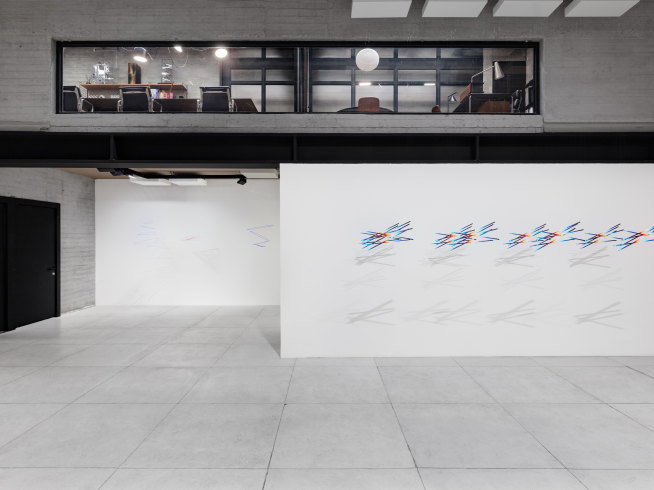
![Detrás de la pantalla [Behind the screen] - 展览 - GALERÍA RGR](https://img.artlogic.net/w_1000,h_1000,c_limit/exhibit-e/5b55e1466aa72c6a718b4568/a3b9c7d48588bbd070c9202fa4c8b123.jpeg)
Behind the Screen
At the cinema, sometimes you can see events as if they’re happening behind the screen and as if the screen were transparent like a showcase. This glass would take the colors from things and would let through only white, gray, and black. (Here we did not put physics into practice, but rather we observed black and white as if they were colors like green or red.) You could also think we’re imagining a showcase that we could say is white and transparent. However, we don’t mean to say that: therefore, does the analogy with a transparent green display case fail in any way?
Ludwig Wittgestein (Observations on colors)
Between the 1940s and 1960s, both in Europe as well as in South America and Asia, artists from diverse backgrounds focused not only on recovering the “pure” properties and essences of art, but also on asking how and when an image that is not reduced to the mere representation of a thing is formed. These artists inquired on the existence of an image a priori, as well as on the experience provided by perception and human consciousness. They delimited the order of things to see and not see at the same time. An intermediate space was conceived, situated between both extremes, between a priori ideas and experience, the body and the spirit. In this enigmatic place where things happen: behind the screen. There, white is no paler than snow and reaches a shade of gray when compared to it. In this intermediate space white is not the same for everyone, it’s not opaque and transparent as it’s usually held in scientific theories of color: How can something transparent be green but not white? Transparency and reflection exist only in the depth dimension of a visual image.
It is the sensible dimension which grants peremptory definitions about space, color, form, line, movement, depth (Paul Cézanne’s great obsession), virtuality, and reality. These aesthetic-philosophical issues—which were at the heart of the concerns of artists and groups linked to kinetic art, Op Art and the new abstraction trends that emerged in the post-war period or linked to accelerated modernization processes in the Global South, —are gaining relevance given the imminent arrival of artificial intelligence.
The artists gathered in the exhibition Detrás de la pantalla [Behind the Screen] capture in the space of the canvas color and movement, the enigma of seeing and not seeing. The impossibility of connecting sensible goals of experience with the reach of science in its eagerness to view things from fixed and stable categories. The smartphone’s screen—just like the canvas or support in painting—flattens what we see. These leave the exclusive dominance of three-dimensionality to sculpture, to what is often superimposed on the naked eye when we perceive an object. However, we know that a chair may or may not contain a body at rest. RGR offers a wide panorama of perspectives from artists who question what we see from this intermediate space that sometimes reverberates behind the screen.
Gabriela Rangel
Exhibition organized by Gabriela Rangel in collaboration with Ricardo González Ramos.
y